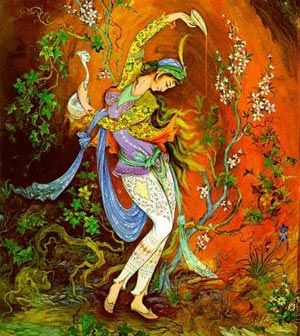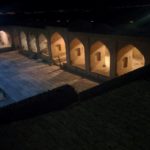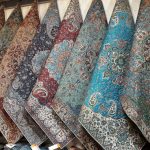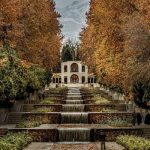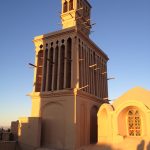Persian miniature
The word miniature is derived from the Latin Minium, meaning ‘red lead’ which was used for pigments in the production of artistic works of ancient Romans and Middle Ages’ artists who illustrated religious manuscripts. In its general modern usage, the term refers to any small-scaled and richly detailed painting. Apart from the Western and Byzantine traditions, there are also Asian traditions in this art form which are as ancient and diverse. Among Asian traditions like Mughal, Ottoman, and Indian practices, Mani (c.216-276), the prophet who rebelled against Zoroastrianism, was a professional artist himself and declared the art of painting as one of his miracles. He even illustrated his sacred book, in which the illustrations were as sacred as the text itself.
The Islamic period
It was, however, after the Arab conquest in 641 and the beginning of the Islamic period, that the art of miniature found its new image. The new Islamic rulers had a dual policy towards the arts.
Newly occupied territories. While on the one hand, they banned the art of painting, seeing it as blasphemous, on the other hand, they decorated their palaces with the images and figures created by Iranian artists in the Manian style of the pre-Islamic age
. Only gradually, what the rulers wanted and allowed came to meet with what the artists practiced and desired. The Islamic rulers came to see and be influenced by the talents of the regional artists, and the masters of different art forms in Iran came to find Islam, especially the manners of the Shiites. This mutual understanding created a new space in which adoring religious books and the holy scripts became popular and paved the way for the illustration of scientific texts and literary volumes very attractive.
Iranian miniature
Under the impact of new religious learning and the reminiscence of the beliefs from an ancient civilization, the artists launched a new era in Iranian miniature. In their small-scaled illustrations, they aimed to create as much as they could to show the grandeur of what they felt and witnessed through the filter of their arts. For them it was the only way to reflect and preserve the history of a nation, which was changing so rapidly due to countless attacks and invasions.
Although the scale of historical events was grand, the size of the picture that recorded them was small. Indeed, the matter of size and scale of Iranian drawings, as one of its unique features, has always been a case of debate. While many see it as an aesthetic feature, some see it as a strategic technique.
The art of painting was banned
According to the latter, since after Islam, the art of painting was banned throughout the country, one of the ways for the artists to practice their art was using their drawings as a small illustration for the books. So they scattered their artworks within the texts and by doing so hid them from evil eyes. The size here was an important parameter, because the smaller size the better concealment, and so the artworks were kept intact and far from intrusion. The texts and lines of the books were used as a haven for the colorful imaginations and dreams of a nation under invasion and book illustration became an inseparable part of Persian artistic history.
History, evolution, and progression The history of Iranian miniature is the Iranian history captured in pictures. The history of a nation with an ancient civilization which has always prided its mythological heroes, mighty kings, brave warriors, bold lovers, grand poets, and honest men and women. As far as the documents show, the first miniature paintings in Iran belong to the beginning of the Islamic period. Between the 7th and 10th centuries, influenced by the Sassanid, Manian, and Byzantine art.
There appeared a mode in painting which was later called the Baghdad or Abbasi School. Here, simplicity was the keyword. The paintings and illustrations produced by the artists of this school were primitive and innovative, painted in flat colors with strong dividing lines.
Images were painted larger than normal without any proportion. They were limited to Some human figures haloed around their heads, with patterned garments, and some unornamented tree branches symbolizing the natural world, awn on plain backgrounds. The drawings were not separated from the written text and seemed to be a part of the whole texture. Apart from the literary works, mainly lyrics and fables, such as Kalileh VA Demneh.
Many scientific books were illustrated by the skillful artists of Baghdad School in this period. The end of the 10th century gave rise to great literary masterpieces in Persian literature, which in turn inspired the great artists, who understood the dialectic of text and image. Ferdowsi’s Grand National epic Shahnameh or The Book of Kings which contained 60,000 rhyming couplets and recounted the history of Iran.
From Kayumars to the Arab conquest (covering The Mythical, The Heroic, and The Historical Ages) provided an endless treasure for those who aimed to tie their art and craftsmanship to mythology, legend, and romanticized history.
The fascination with Shahnameh was so immense that every historical period in Iran has created its own illustrated version of this masterpiece and one can easily trace the history of Iranian miniature by analyzing the copies produced throughout the centuries.
miniature schools
The Fars & Khorasan school appeared between the 11th and 12th centuries during the reign of Seljuk. In this period, the Iranian art revived itself in the form of paintings on pottery and book adornments.
The literary masterpiece of this period was Khamseh (five epics) by the grand poet Nezami, who like Shahnameh inspired many artists. Nezami spent 30 years composing this work; best-known for the love story between the king of Persia Khosro and princess Shirin. The paintings of this school used red color as their background together with a completely contoured style in representing bodies, plants, animals, and natural landscapes.
Mongols
The devastating invasion by Mongols happened in the 13th century leaving many Persian cities in ruins and innumerable people dead. In the course of these savage invasions, wall paintings inside palaces were destroyed and thousands of manuscripts both illustrated and non-illustrated were burned to ashes when libraries across the country were put to flame. Only gradually, the Ilkhanid court started to respect and later promote the native traditional artistic and cultural practices. It was under these new rulers and foreign trades that Iranian artists became familiar with Chinese works and probably artists, with their long-established tradition of narrative painting.
Tabriz
In the new capital city, Tabriz, a new school was born bearing the same name. The practitioners of this school had the advantage of borrowing the different modes of paintings from Baghdad, Chinese, Byzantine, and even Buddhist traditions all of which were reflected in their paintings. Their illustrations,
which in times occupied a separate full page, are predominantly horizontal in format framed and checked with a simultaneous display of the external and internal spaces in the landscape, peopled by figures wearing Eastern armors and silk garments in Chinese style.
Shiraz
At the same time that Tabriz School was flourishing in the west, miniature painting found another home in Shiraz in the south. Shiraz was of course the home of master poets such as Saadi, Khajuye Kermani, and horizontal in format, framed and checked, with a simultaneous display of later Hafez.
Following the death of Abu Sa’id (1316-1335), the last IKhanid ruler, and for the rest of the 14th century, Iran was ruled by several local dynasties whose capitals developed highly distinctive provincial styles of painting: the Jalayerids (1340-1411) in Baghdad, the Chupanids (1337- 1357) in Esfahan, and the Injuids (1325-1353), followed by the Muzaffarids (1314-1393), in Shiraz.
The style of painting in each city was different and every area came up with its mode. However, one thing was for certain -in a period after the collapse of the Seljuks, and before Timur’s invasion, miniature found new vitality and flourished under many independent schools bringing ancient Iranian tales and poems into the center stage. The most important miniatures made in this period were from Khajuye Kermani’s Homai and Homayoon. The pictures of the Jalayeri School depicted vast and infinite landscapes, the nature was fictional and poetic more than ever, the world seemed unrealistic and imaginary to go with the figures and scenery, the compositions were circular and spaces were so divided to represent only two dimensions.
Timur
The invasion of Timur in 1381 changed the political, and thus the cultural air in Iran. As a result, Samarqand became the capital of the new dynasty and attracted the artists as the new cultural hub. One of the most distinguished styles triggered during that period was a combination of Jalayerian and Mozaffarian schools together with elements and details supposedly portraying traditions of Middle Asia. So, the first classical or official style was formed in Iranian miniature. Meanwhile at Shiraz the individual artists continued to create wonders.
Free from the influences of the Chinese and Byzantine arts there appeared miniatures with lofty horizons, realistic details of nature and human figures, men sitting scantly on horsebacks. Mystical and Romantic themes were dominant and human behaviors were depicted to match the emotions running in the texts.
The best examples of this School are Ebn Hesam’s Khavaran Nameh and Shahnameh of Ibrahim Sultan, with fifty-two paintings. Herat became the capital city when Sharokh, Timur’s son succeeded in court, and homed a new school in miniature by the same name for half a century.
Herat in Afghanistan
As the new cultural hub, Herat, now in Afghanistan, became a magnet for the talented miniature artists, calligraphers, goldsmiths, and bookmakers of Baysongor’s court. The miniature artists created some of the most appreciable pictorial manuscripts in the history of eastern paintings. Those miniatures were created in absolute balance of scale, composition, and color selection. Baysonqory Shahnameh is a unique and unparalleled masterpiece created by Mulla Ali and Amir Kalil under the patronage of Baysonqor Mirza, the prince himself. In the Herat miniature painting, human figures became much more prominent.
Realistic details of flowers and plants, accurate drawings of architectural landscapes, skillful and asymmetrical compositions. complicated and cross-sectional spacing, as well as the variety of colors are amongst the outstanding features of this school. The Herat artists were also exceptional at portraying people.
COne of the best known and most influential painters from the Herat school was Kamal-od-Din Behzad, whose paintings brought miniature to its genuine bloom, and was greatly influenced by the works of the Persian poets, especially Jami. Jami (1414-1492) who is commonly called the last great classical poet of Persia, saint and mystic, was the composer of Haft Awrang’. Behzad followed Herat classical school to create his best works of art and along with his contemporary artists managed to refine and perfect the classical style of Timurids. At the beginning of the 16th century the Safavid dynasty came to power, and Shah Esmail made Tabriz the capital city once again. In miniature art, the second Tabriz School emerged by the synthesis of diverse traditions from the Herat heritage and the first Tabriz School, developing a new path towards excellence in quality and quantity. The richness and variety of colors, compact, and in times spirals, compositions, and dynamic figures made the illustrations of this period very plausible. 1he use of golden colors, themes from court life and attire, dressing e figures in genuine Safavid garments and hats, and depiction of hunting scenes with astounding mobility, are among the features of this period “Khamseh’ by Nezami and Tahmasp’s Shahnameh are two magnificent examples of this period, which once again embody the magical fusion of words and images. Tahmasp’s Shahnameh was commissioned by Esma’il’s son and successor, Shah Tahmasp (1524-1576) and is known to be the most sumptuous manuscript in the history of Persian painting. Tahmasp invited Kamal-od-Din Behzad, his art teacher from Herat, to Tabriz in 1522, where he became the head of the royal library and entrusted Soltan Mohammad, another talented miniaturist, with the illustration of Tahmasp’s Shahnameh. Illuminated with 258 miniature paintings sprinkled with gold, this version was completed over thirty years. This version is also known as Houghton Shahnameh, after Arthur Houghton, who bought it in 1959 and soon proceeded to take apart the folios to individually sell the pages containing the miniature paintings. Sadly, the history of Shahnameh is the epitome of the history of a nation. It was rediscovered by every invader, was commissioned to native artists by total aliens, used in times as diplomatic gifts, as was the case with Tahmasp’s Shahnameh which was given to the Ottoman Sultan Selim II, dismembered and finally sold off or stolen. In a sense, the Shahnameh offers not only a panoramic view of the history of Iran through Persian painting for well over a thousand years but also depicts the dramatic and painful history of the rapid succession of alien dynasties which took to art patronage only as a reflection of their majesty and dominance. The next school which emerged in the art of miniature by synthesizing the second Tabriz and regional elements was the Mashahd School. This school gains importance because in its miniatures the human figures and objects appear without any connection to the stories. Additive personages from everyday life are depicted as part of the scene, with tall human figures with round faces. Nature was featured with blocked rocks and old trees with bulky trunks and twisted branches. White was the dominant color of the paintings. The most prominent illustrated work of this school is Jami’s great poetic masterpiece the Haft Awrang. Jami’s poetry inspired and enabled the artists to use the characters, themes, and motifs of the literary world in creating more lively figures within the compositions that were no longer constrained or static. The landscapes gave the full illusion of the scenes from the poetic world, creating in a limited space an unlimited architectural possibility that included palaces, buildings, outer yards, and inner gardens at the same time to enable the reader and the viewer to step inside the fictional worlds immediately. During the same period when Qazvin became the capital city, the Qazvin School was born as a common precedent. The reason why this school is usually mentioned in the history line of Persian miniature is because it was with this school that individual miniature works were created detached from texts and books. Drawings and paintings were no longer bound to illustrations of texts or adorning literary volumes. Individual figures or young couples were painted and then the works were decorated with calligraphies. Wall paintings in the palaces and portraits became popular art forms. However, Shahnameh was an exception. The most well known illustrated copy of this period is Shahnameh of Ghavam Ibn Mohammad Shirazi, with 37 paintings and his calligraphy. Finally, Esfahan, the most famous Iranian city known for the Westerners, became the capital city of Shah Abbas I. Himself a painter, the Shah paid special attention to restorations of old works and patronage of the new. Miniatures became more and more sophisticated as more and more masters joined the practice. One such master was Reza Abbasi (1610-1640). The miniatures produced by the Esfahan School are visibly distanced from the art works produced for book illustrations. In an open effort for independence the themes of the new works centered around events in the royal court, the aristocratic class, magnificent palaces, and hunting scenes. The number of human figures in a single picture declined; instead the details in depicting the face, hair and beard, and even the pelts of the closing were put to center stage through the use of subtle brush strokes. Influences of Indian and European art were welcomed causing a gradual change of taste in the new works. As Taslimi notes, European and Armenian artists present at Esfahan had their share in introducing oil color painting to the Iranian artists and gradually changed the face of Iranian miniature art forever. The size of the human figures to natural proportions, the use of second and third dimensions, and the foreign modes of perspective, were other new features practiced by artists in this period. One drastic change in this era was the separation of miniature and literature. A sad ending for the collaboration of two incredible art forms, which had been fueling energy into the veins of one another for centuries. The new modes of painting stressed on verisimilitude and realism, which was far from the spirit of the literature of the time. The third space of imagination was giving way
to the natural surroundings, the every day figures mostly for decorative purposes. Shahnameh yet was still an exception and this time appeared under the name of Shahname ye Abbasi. After the Safavids, under the Afshar, Zand, and Gajar dynasties right through the Pahlavi’s and after the 1979 revolution, Iranian miniature witnessed drastic changes. When Westernized styles started to flourish in the country, everything including Iranian painting entered a new era. Iranian miniature experienced Flower and Bird School of Shiraz, Academy of Iranian Arts was founded, and then came grand masters of painting such as Kamal-Ol-Molk (1847 1940), Hossein Behzad (1894-1968), and others like Hadi Tajvidi and Mahmoud Farshchian, who introduced new methods of composition and perspective, and created a unique masterpiece.

